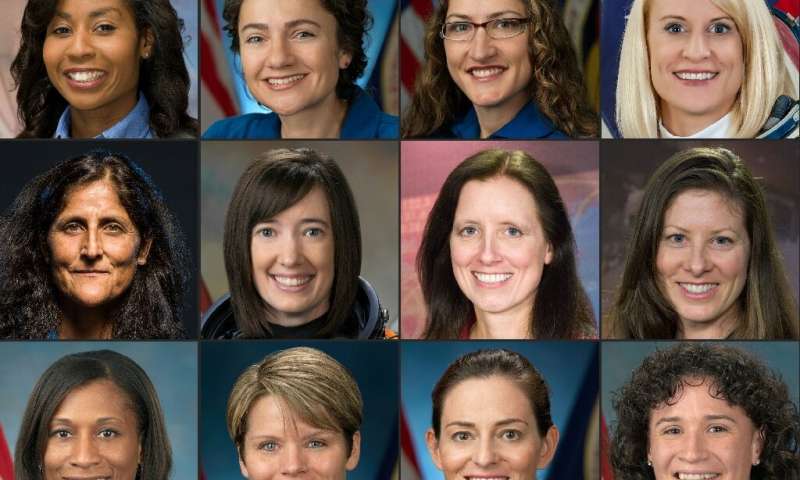
Who will take the giant leap for womankind?
More than fifty years after the end of the Apollo program, NASA plans to return to the Moon by 2024 as a “proving ground” to test the next generation of spacecraft ahead of an eventual crewed mission to Mars.
The new program has been named Artemis after Apollo’s twin-sister in Greek mythology, and the space agency has said that the mission will see the first woman to stride the lunar surface.
So, who will she be? No one knows for sure, but it’s a likely bet the candidate will be selected from among NASA’s current roster of 12 female astronauts.
They’re aged between 40 and 53, and are former military pilots, medical doctors and scientists who were picked from among thousands of applicants since the late 1990s.
Predicting who will join Neil Armstrong in the annals of history isn’t an exact science, but several former astronauts and experts interviewed by AFP say the proximity of the deadline mean it probably won’t be a new recruit.
“Now personally, I’d be okay with flying a rookie astronaut to the Moon,” former astronaut Eileen Collins, who flew and commanded Space Shuttles in the 1990s and 2000s, told AFP.
“But if you have enough astronauts who have already flown, they know how they’re going to react in space.
“Some go up there and they have symptoms that might interfere with their ability to do the work. But you don’t know who that is.”
Ken Bowersox, a senior official at NASA, agreed. “I think it will be better to send people who have had at least one flight,” he told AFP.
That objective will be easier than ever before because there have never been so many women astronauts.
When NASA was first established in 1958 it only recruited from the military, which was at the time exclusively male.
All 12 moonwalkers between 1969 and 1972 were men, and it wasn’t until 1983 that Sally Ride became the first American woman sent to space.
Scientists and soldiers
The four women of the 21st class of astronauts, recruited in 2013, represent a good mix of youth and experience. Currently between the ages of 40 and 41, they will all have made their first space forays between now and 2020.
Anne McClain, an ex-army helicopter pilot, will be in the International Space Station (ISS) until the end of June.
Well spoken, with a self-assured gaze and a light smile, she embodies the ineffable “right stuff” of NASA’s early recruits.
Also currently in the ISS is Christina Koch, an engineer and passionate mountain climber. She will soon beat the record for the longest time a woman has been in space, at 11 months.
Back in March, the pair almost conducted the first all-female space walk, but a lack of a proper fitting spacesuit meant McClain had to give her place up for her male colleague Nick Hague.
“I think Christina Koch or Anne McClain would be my two top picks,” said Janet Ivey, the presenter of a children’s show on space and a governor of the National Space Society.
But their two female colleagues from the same class, Jessica Meir, a marine biologist who specializes in penguins and geese, and former F/A 18 fighter pilot Nicole Mann, who flew in Iraq and Afghanistan, are also highly qualified.
They are both in the middle of their training to go to the ISS.
In a 2016 interview, all four declared themselves ready to go to Mars if the opportunity presented itself. It’s hard to imagine them turning down a trip to the Moon.
Opaque process
There’s no upper age limit for space. The iconic John Glenn made his last flight at the age of 77 as a US senator.
There’s nothing therefore excluding the highly experienced Sunita Williams, who is preparing for her third space mission and will be 58 in 2024.
Especially since NASA has long “appreciated the leadership skills that came along with test pilots,” according to Kent Romninger, the former chief of the astronaut office from 2002 to 2006.
“Suni,” as she’s known, has piloted about thirty different aircraft in her military career.
Two other women, Serena Aunon-Chancellor and Kate Rubins, have also flown to space recently.
The other five haven’t flown since 2010 but remain on active duty.
There are five women in the 2017 batch but they have yet to complete their initial training.
They’re not ruled out yet, but the calendar isn’t on their side—especially since NASA tends to stick to a cycle of astronauts once their order is set, says Michael Lopez-Alegria, a former astronaut who spent 20 years with the agency.
When it comes down to the final call, though, the process “is fairly opaque,” he conceded.
In Houston, the chief astronaut will be keen to build a team whose profiles will be complementary, a mix of ex-military and scientific backgrounds, and of different personalities.
The mission forsees a four-member crew, two of whom will walk the Moon. Why not have two women?
